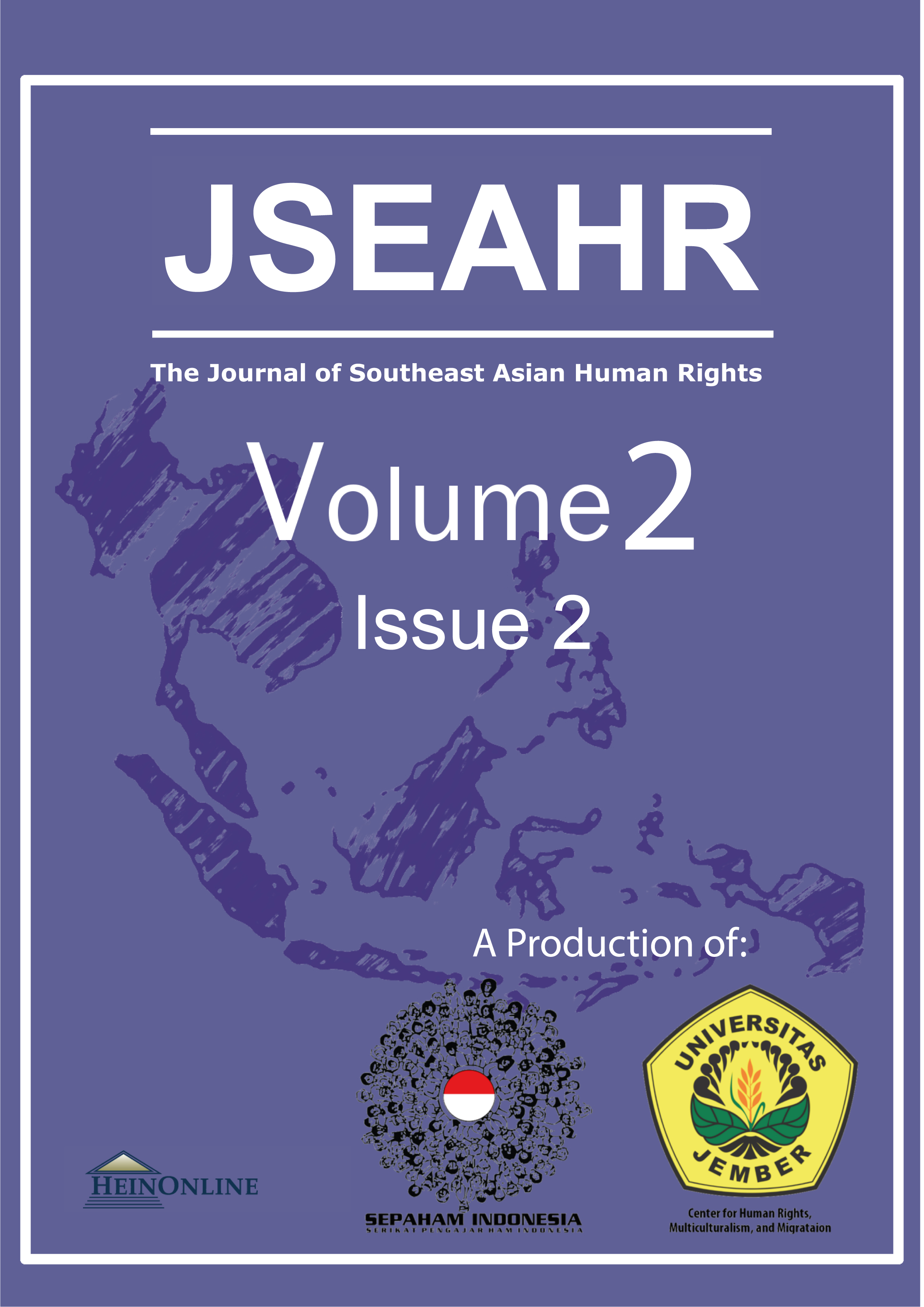Transnational Islam, Regional Terrorism, and Military Power: The Rise of Muslim Special Unit in the Philippines Armed Force
DOI:
https://doi.org/10.19184/jseahr.v2i2.8363Keywords:
Transnational islam, Regional Terrorism, Muslim Special Unit, The Philippines MilitaryAbstract
The Southern Philippines is known as one of the areas that never get out of conflict. Even in 2017 the public was shocked by the emergence of the Maute group in Marawi which affiliated with ISIS or Daesh transnational terrorists. They undertake a lot of human rights violations such as kidnapping and murder. In addition, terrorist groups that have existed before like Abu Sayyaf often operate by crossing several Southeast Asian countries waters boundary, so the problem is transformed into a regional issue. To face this problem, the Philippines government formed a Muslim special unit in their military power. On the one hand, it’s has a positive impact: (1) Religious and cultural approach will open up a larger dialogue space compared to a conventional military approach; (2) More adaptable and diffuse to gain local community support; and (3) Greatly facilitate coordination and cooperation with the military of Indonesia, Malaysia, and Brunei Darussalam as a country with Muslim majority population. But on the other hand, it’s also has a negative impact: (1) Potential emergence of factions within the military or gap between the Muslim units with other soldier; and (2) Reinforcing the stigma that Muslims are terrorists and must be fought with hard-core Muslim behind military uniform.
Downloads
References
Affandi, Hakimul Ikhwan, Akar Konflik Sepanjang Zaman: Elaborasi Pemikiran Ibn Khaldun, (Yogyakarta: Pustaka Pelajar, 2004).
Agence France Presse, Philippine Army Plans All-Muslim Units, online: http://www.thehindu.com/news/international/philippine-army-plans-all-muslim-units/article18061477.ece, (July 20, 2017).
Al-Jazeera, Philippines: 11 Soldiers Killed in Misdirected Air Raid, online: http://www.aljazeera.com/news/2017/06/philippines-10-soldiers-killed-friendly-fire-170601031851380.html, (July 18, 2017).
Alexander, Yonah, “Contemporary Terrorism: From National to Regional and Global Threatsâ€, Defence Against Terrorism Review Vol. 1 No. 2, (2008).
Baviera, Aileen and Jay Batongbacal, The West Philippine Sea: The Territorial and Maritime Jurisdiction Disputes from a Filipino Perspective, (Manila: The Asian Center and Institute for Maritime Affairs and Law of the Sea University of the Philippines, 2013).
Bell, Christine and Vanessa Utley, “Chronology of Mindanao Peace Agreementsâ€, The Political Settlements Research Programme Briefing Paper Vol. 2, (2015).
British Broadcasting Corporation – BBC, Marawi Siege: US Special Forces Aiding Philippine Army, online: http://www.bbc.com/news/world-asia-40231605, (July 18, 2017).
Brunet-Jailly, Emmanuel, “The State of Borders and Borderlands Studies 2009: A Historical View and a View from the Journal of Borderlands Studiesâ€, Eurasia Border Review Vol. 1 No. 1, (2009).
Chapman, Bert, “China's Nine-Dashed Map: Continuing Maritime Source of Geopolitical Tensionâ€, Geopolitics, History, and International Relations Vol. 8 No. 1, (2016).
Dewi, Ita Mutiara, “Pengalaman Militer Burma: Sebuah Analisis Historis-Politisâ€, Istoria: Jurnal Pendidikan dan Ilmu Sejarah Vol. 1 No. 1, (2005).
Emmers, Ralf, “ASEAN and the Securitization of Transnational Crime in Southeast Asiaâ€, The Pacific Review Vol. 16 No. 3, (2003).
Global Fire Power, 2017 Philippines Military Strength: Current Military Capabilities and Available Firepower for the Nation of Philippines, online: http://www.globalfirepower.com/country-military-strength-detail.asp?country_id=philippines, (July 17, 2017).
Gowing, Peter G., “Moros and Khaek: The Position of Muslim Minorities in the Philippines and Thailandâ€, in Reading on Islam in Southeast Asia, ed. Ahmad Ibrahim et al., (Singapore: Institute of Southeast Asian Studies - ISEAS, 1985).
Hashim, Ahmed S., The Impact of the Islamic State in Asia: Policy Report, (Singapore: S. Rajaratnam School of International Studies - RSIS NTU, 2015).
Jones, Sidney, “Pro-ISIS Groups in Mindanao and Their Links to Indonesia and Malaysiaâ€, Institute for Policy Analysis of Conflict (IPAC) Report Vol. 33, (2016).
Kusuma, Bayu Mitra A., Abu Sayyaf Piracy: An ASEAN Political Security Challenge, online: http://isais.or.id/en/abu-sayyaf-piracy-an-asean-political-security-challenge, (July 4, 2017).
Kusuma, Bayu Mitra A., “Islam, Asymmetric Policy, and Social Conflicts: The State’s Role as a Root of Radicalism in the Philippines and Thailandâ€, IKAT: The Indonesian Journal of Southeast Asian Studies Vol. 1 No. 1, (2017).
Kusuma, Bayu Mitra A., “Mengelola Perbatasan dengan Border Governanceâ€, Jawa Pos Radar Banyuwangi, (Saturday, April 16, 2016).
Kusuma, Bayu Mitra A., “Mereduksi Islamofobia Melalui Aksi Nyata Lintas Iman: Sebuah Kritik Sosialâ€, in Keberpihakan dan Kepedulian Lintas Iman Untuk Difabel, ed. Bayu Mitra A. Kusuma and Zaen Musyirifin, (Yogyakarta: Interfidei, 2016).
Laqueur, Walter, The New Terrorism: Fanaticism and the Arms of Mass Destruction, (New York: Oxford University Press, 1999).
Nugroho, Irwan, Investigasi: Menelusuri Mata-Mata Abu Sayyaf, online: https://x.detik.com/detail/investigasi/20161013/Menelusuri-Mata- mata-Abu-Sayyaf/index.php, (July 13, 2017).
Ortega, Gracel, AFP Looking to Establish Battalion-Size Muslim Soldiers, Then Develop into Brigade Division, online: https://www.update.ph/2017/04/afp-looking-to-establish-battalion-size-muslim-soldiers-then-develop-into-brigade-division/16806, (July 20, 2017).
Raymond, Gregory Vincent, “Naval Modernization in Southeast Asia: Under the Shadow of Army Dominance?â€, Contemporary Southeast Asia Vol. 39 No. 1, (2017).
Rustandi, Agus, The Impact of China’s ‘Nine-Dash Line’ Claim on ASEAN’s Role in the Indo-Pacific Region, (Canberra: The Centre for Defence and Strategic Studies (CDSS) Australian Defence College, 2015).
Sanak, Yohannes, Human Security dan Politik Perbatasan, (Yogyakarta: PolGov UGM, 2014).
Snyder, Craig A., Contemporary Security and Strategy, (New York: Palgrave Macmillan, 2008).
Tan, Andrew, Force Modernisation Trends in Southeast Asia, (Singapore: Institute of Defence and Strategic Studies - IDSS NTU, 2004).
United States Institute of Peace, “Teaching Guide on International Terrorism: Definitions, Causes, and Responsesâ€, Education Program Vol. 202, (2001).
Van Houtum, Henk, “The Geopolitics of Borders and Boundariesâ€, Geopolitics Vol. 10, (2005).







